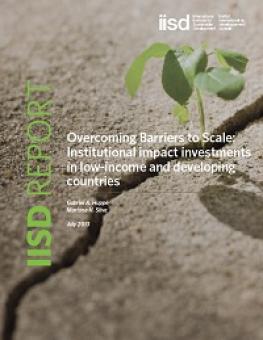
Overcoming Barriers to Scale: Institutional impact investments in low-income and developing countries
As an investment intended to create positive impact beyond financial returns, impact investing is seen as an appropriate and economically effective way to complement government procurement and philanthropy in solving the world's greatest problems at scale.
Initially the purview of foundations, impact investing has become a viable asset class for a large variety of investors, ranging from wealthy individuals to pension and sovereign wealth funds. Although impact investment, as an asset class, is perceived as still being in its infancy, some studies have estimated that the amount of capital allocated to impact investment could grow to USD$500 billion within five to ten years, which would represent 1 per cent of global assets under management.
Upon reviewing recent reports on impact investing by various organizations, the authors noted that there is conceptual appeal for large institutional investors to participate in the impact market. However, due to unresolved barriers, large investors such as pension and sovereign wealth funds are unable to participate in this attractive investment thesis of the asset class. Based on an analysis of the seven key problems facing institutional investors wishing to participate in impact investing, we provide a series of recommendations for key industry players and public policy-makers. We propose a focus on financial instruments, host regulatory mechanisms and policy initiatives. In particular, we suggest that innovations in financial instruments and fund structures may help resolve the primary challenges faced by pension and sovereign wealth funds, while government support can help reduce the barriers related to secondary problems. We also discuss an ecosystem approach to impact investing and entrepreneurial activity and apply this framework to the Indian ecosystem.
We integrate our various findings and propositions into a framework to evaluate National Impact Investment Readiness, which can be used by both the financial industry and policy-makers in low-income and developing countries. The financial industry can use this framework to assess the "investability" of emerging impact investment markets in terms of making an impact in these countries, all while achieving returns that are in line with their fiduciary obligations.
The National Impact Investment Readiness Assessment can thus help investors prioritize impact investment markets and sectors at the country level. Policy-makers in countries with a national agenda to promote impact entrepreneurialism and enterprise-based development can also use the tool.
You might also be interested in
The Investment Facilitation for Development Agreement: A reader's guide
A subset of World Trade Organization members has finalized the legal text of an Agreement on Investment Facilitation. This Reader's Guide provides an overview of what's in the agreement.
Navigating Decisions: The risks to Mozambique from liquified natural gas export projects
A brief highlighting that the multiple risks with LNG export projects in Mozambique undermine their expected contribution to economic development.
Brochure: IISD’s Sustainable Investment Advisory Services
IISD's Sustainable Investment team provides customized training, workshops, and advice to developing countries across the world.
IISD Annual Report 2022–2023
At IISD, we’ve been working for more than three decades to create a world where people and the planet thrive. As the climate crisis unfolds on our doorsteps and irreversible tipping points loom, our team has been focused more than ever on impact.